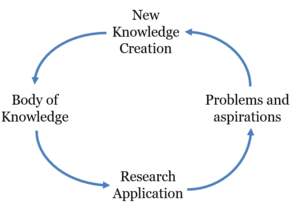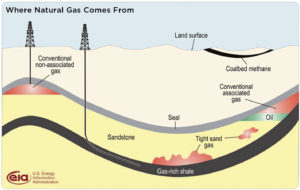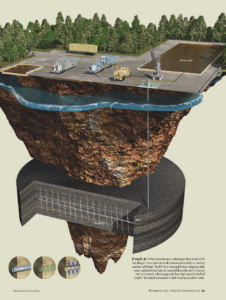Applied Research in Practice: Two Scenarios
For 99% of the planet Applied Research Methods (ARMs) is as abstruse a topic as, say Functional Analysis.1 But Applied Research powers modern development. If you’re developing weapons, oil, new financial instruments, or big-ticket high tech, you’re almost certainly using ARMs extensively in development. If you’re outside of this elite or the scientists that service them, ARMs are likely alien; but they shouldn’t be.
Knowledge Production and Application: Theory
Figure 1. How Applied Research Works (in theory)
Figure 1 illustrates how knowledge production is should work:
- Society and its entities have problems (e.g., health, welfare, security and sustenance); as well as aspirations (e.g., economic development, exploration and political influence, etc.…). (Figure 1 right.)
- Scientists and scholars are employed and often directly funded to address these problems/ aspirations or uncover basic understanding that can illuminate them. In doing so, they create new knowledge, encoded mostly in books and journal articles, but also in various other documents, data sets, lectures, etc.… (Figure 1 top.)
- Each new contribution is small, but collectively these works comprise a vast body of knowledge incorporating all that is known – or at least published – and organized variously by discipline, title, and tag or topic. (Figure 1 left.)
- From these vast bodies of knowledge, people can draw the understanding and insight needed to solve important problems and attain the aspirations with which we began, in short apply research to the betterment of society and its individual entities. (Figure 1 bottom.)
Example 1: Developing a Huge New Natural Gas Reservoir
Colossal Energy Inc. finds a huge new reservoir of natural gas, but there’s a problem: traditionally gas is tapped from reservoirs trapped in well-connected pores in a rock such as sandstone. Once tapped, the gas rises to the surface, often under its own drive, for collection. Colossal’s huge find, however, is trapped in reservoirs of rock, e.g., slate, with tiny unconnected pores.
Figure 2. Where natural gas
comes from
(click to enlarge)
In common parlance, problems are unwelcome tribulations, but science and enterprise alike recognize problems as opportunities. Colossal Natural Gas Division’s CEO notes that, “if the find were easy to tap, it would have been tapped already.” He brings in his team and gets right to the point: “there’s a huge amount of gas there; how do we get it out?”
The team explores for as long as it takes, at first at a high level, drawing on a wide range of perspectives, consulting with anyone and everyone who has done work that might be useful. Rather than bear the full brunt of these exploratory analyses, Colossal will collaborate with other energy firms who have similar finds.
As much as possible they’ll draw on outside resources, research done by universities, other research institutions and national laboratories.2 They might even obtain state or federal funding for internal research and development to be conducted by their own people and for which Colossal will obtain patents and other private exploitation rights.
As the research develops, Colossal will continually revise and reevaluate parameters: What are the options? How much will it cost? How much gas will it yield? What kind of ROI can we expect? How does it compare with other technically challenging alternatives, e.g. arctic, deep ocean, etc.…?
Figure 3. Fossil Fuel Extraction: Getting it Done
Once the endeavor seems practicable, development is almost manifest without regard to obstacles. Colossal geologists draw on expertise of rock formations and use ARMs to identify specific formations in the Colossal find. Chemists do likewise with respect to its composition and determine how that composition can be made more porous. Physicists, engineers and machinists of all stripes figure out how to deep drill horizontally. Environmental scientists determine what environmental legislation they can comply with and what laws will need to be changed or repealed. For specialized challenges or other issues beyond the scope of their internal capabilities, Colossal might continue to collaborate with “competitors” and other stakeholders; often prominent scientists and labs with whom the company and industry have long-standing funding relationships. And in the end, they roll over every obstacle without any undue delay, and get it done (see Scientific American diagram). 3
The modern world depends on energy; and like almost everything else that the modern world depends on, energy depends on research. But the realms in which this cycle works so well are highly circumscribed. Even the Colossal Energys of the world that employ research so effectively in core competencies, usually fall short in other areas.
Example 2: A Research Applications Gap: New Workspace
Put yourself in the shoes of the Director of Building Operations (DBO) for the Colossal Corporate Campus, a sprawling 300-acre, 15-building, 8,000-employee (+4,000 temps) complex that includes the corporate headquarters. (Some 150 of these employees and another 200 contract workers report to you!)
Your supervisor alerts you that top management is considering transitioning the workforce throughout the company from “out-moded” private offices to modern “flex-space.” They’d like your input on this, especially with regards to beginning this process with the corporate campus. Soon.
He adds: “everyone’s doing it, not only tech; look at pharma, the banks, the consultants, etc.….” He briefs you on “management’s thought process”:
- Most private offices are unoccupied for most of the day. People are traveling, in the field, etc.… Even when they’re “in,” they’re in meetings, conference rooms, at lunch, etc.…
- We need more space for the itinerants (i.e., sales people, inspectors and other field workers who come in to HQ a few days per month).
- We need more flexible space for temp influxes (e.g., for project work such as the horizontal drilling initiative mentioned above)
- We want to be more innovative, interdisciplinary … get people to work together. We’re “too siloed”; Colossal needs more “informal interaction,” “serendipity,” “collisions.”
- The campus is a statement. We’re big, we’re respected, but we need to also be “cutting edge.”
It’s a typically busy day; you work till 6 pm; don’t arrive home till 7 pm; and then it’s dinner and family time. You don’t really have a chance to even think about the new request until after the kids are in bed, 9 pm or so. And soon it’s your bedtime, which you don’t want to cut into as you need to get up at 5:45 the next morning to be in the office and ready to work at 8.
Lying in bed: Of course, as Colossal’s DBO you’re aware of this trend away from private offices; there’s nothing new to you about “management’s thought process.” But your gut feeling is negative. Indeed, when you first heard of the trend, you could hardly understand … not even a cubicle to call your own? not even a desk? You yourself are one of those who’s out in the field most of the day, maybe only two hours in the office on a typical day. But you feel like you need your office. It’s where you have private conversations. It’s where you can get away and collect your thoughts. It’s where you keep your stuff! You have the chair that you need – Jesus, your back was always in spasm till you got that chair. You have your pictures and mementos that provide both solace and motivation …
Arriving in work next morning, you have mountains of mounting responsibilities all piled on top of a full workload of day-to-day operational practicalities. Still, you’ve asked for input. And you’d like to be able to provide it. and so, when you can steal a bit of time later in the week, you think about it. But how to begin? : Unlike the Division CEO, you have no research budget and limited office staff, none of whom have ever researched anything more than airfares. ….
Specific instructions: Take 20 minutes to
* provide the input you would provide if management were to request it immediately
* identify what steps you would take in order to prepare more thorough input for top management.
I’ll give feedback to the first respondents as I would to our doctoral students.
References
Freeman , Steve (2018-09-18) ARMs for the Rest of Us. http://sffreeman.com/blog/2018/09/18/arms-for-the-rest-of-us/
Mooney, Chris. “The truth about fracking.” Scientific American 305.5 (2011): 80-85.
Novak, Matt (2014-12-11) GIZMODO https://paleofuture.gizmodo.com/weve-been-incorrectly-predicting-peak-oil-for-over-a-ce-1668986354
Notes
- Some other abstruse topics: S-matrix theory, Vedanta, others?
- Sandia National Laboratories https://energy.sandia.gov/climate-earth-systems/energy-geoscience-and-engineering/challenges/unconventional-shale-science/
- This knowledge production-application process can be phenomenally successful. Since oil was first discovered in the late 19th century (Titusville, PA) the world has continually predicted, indeed presumed, reserve decline. Here’s a typical headline and snip from 100 years ago:
Two to five years until maximum production
… In meeting the world’s needs, however, the oil from the United States will continue to occupy a less and less dominant position, because within the next two to five years the oil fields of this country will reach their maximum production and from that on we will face an ever increasing decline. … — October 23, 1919 Oil and Gas News
Yet despite extracting ever-increasing volumes of fossil fuels, reserves are now higher than ever, with no end in sight to continued increases (Novak 2014)
 Scientific American, “Crack it”
Scientific American, “Crack it”